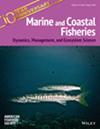Variation in energy density of northwest Atlantic forage species: Ontogenetic, seasonal, annual, and spatial patterns
Abstract
Objective
Energy density (ED) estimates for marine forage species have been limited, impeding our understanding of this important trophic level. We studied the EDs of eight key forage species: Alewife Alosa pseudoharengus, Atlantic Herring Clupea harengus, Silver Hake Merluccius bilinearis, Northern Sand Lance Ammodytes dubius, Atlantic Mackerel Scomber scombrus, Butterfish Peprilus triacanthus, northern shortfin squid Illex illecebrosus, and longfin inshore squid Doryteuthis pealeii (also known as Loligo pealeii).
Methods
Samples were obtained during spring and fall bottom trawl surveys across five regions (Gulf of Maine, Georges Bank, southern New England, northern Middle Atlantic Bight, and southern Middle Atlantic Bight) from 2017 to 2019. In the laboratory, we developed predictive relations between the percent dry weight (%DW) and ED (kJ/g wet weight) determined by proximate composition analysis (n = 606; r2 = 0.76–0.98) to estimate the ED of additional samples (n = 4583). For each species, we modeled ED as a function of size, depth, season, and year (as factors) as well as location (latitude, longitude) using generalized additive models (GAMs).
Result
Alewife, Atlantic Herring, Northern Sand Lance, Atlantic Mackerel, and Butterfish were classified as high-quality prey (ED > 6 kJ/g), although Atlantic Herring ED was nearly half the values reported in earlier studies. Silver Hake, northern shortfin squid, and longfin inshore squid were classified as moderate-quality prey (4 kJ/g < ED < 6 kJ/g). Most species had higher EDs in the fall following summer feeding than in the spring after spawning and/or reduced winter feeding. The best-fitting GAMs included weight, depth (by season), season, and year effects for most species. Location (by season) explained significant amounts of variation.
Conclusion
Observed variation in ED across regions, species, seasons, and years provides the empirical data necessary to consider hypotheses related to “upstream” regulation of ED (via environmental drivers and productivity) and “downstream” effects on recruitment for these forage species as well the species that prey on them.


 求助内容:
求助内容: 应助结果提醒方式:
应助结果提醒方式:


